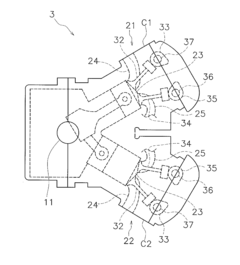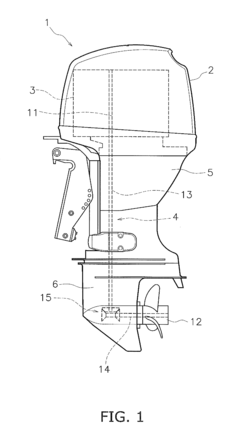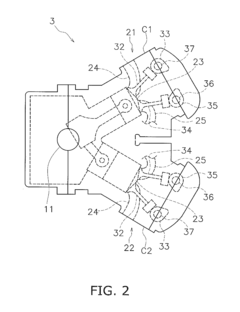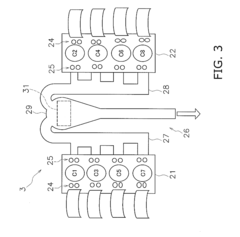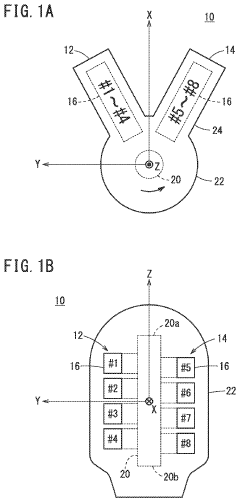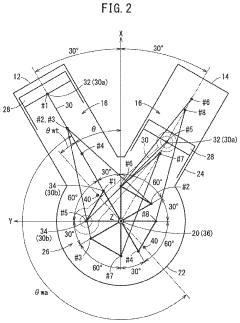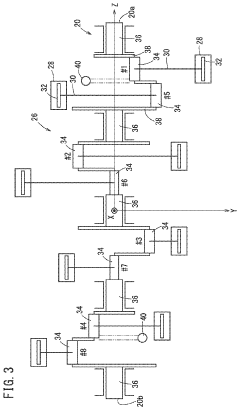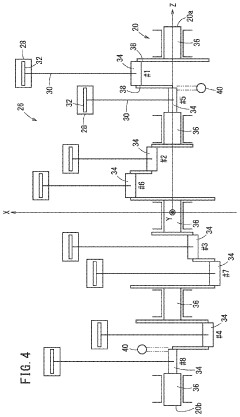Exploring V8 Engine Compatibility: Various Applications
JUL 4, 20259 MIN READ
Generate Your Research Report Instantly with AI Agent
Patsnap Eureka helps you evaluate technical feasibility & market potential.
V8 Engine Evolution and Objectives
The V8 JavaScript engine, developed by Google, has undergone significant evolution since its inception in 2008. Initially designed to enhance JavaScript performance in Google Chrome, V8 has become a cornerstone of modern web development and server-side applications. Its primary objective has been to execute JavaScript code at high speeds, continuously improving performance and efficiency.
Throughout its development, V8 has introduced several groundbreaking features. The introduction of the TurboFan optimizing compiler in 2015 marked a significant milestone, replacing the older Crankshaft compiler and dramatically improving JavaScript execution speed. This was followed by the implementation of the Ignition interpreter in 2016, which reduced memory usage and improved startup times.
V8's evolution has been driven by the changing landscape of web applications and the increasing complexity of JavaScript-based systems. The engine has adapted to support new ECMAScript features, ensuring compatibility with the latest JavaScript standards. This commitment to staying current has been crucial in maintaining V8's relevance and performance edge in diverse applications.
One of the key objectives in V8's development has been to enhance its compatibility across various platforms and applications. This goal has led to the engine's integration into Node.js, enabling server-side JavaScript execution and opening up new possibilities for full-stack JavaScript development. The engine's versatility has also made it a popular choice for embedding in other applications, extending its reach beyond web browsers.
Performance optimization remains a central focus of V8's evolution. The engine continuously refines its just-in-time (JIT) compilation techniques, garbage collection algorithms, and memory management strategies. These improvements aim to reduce latency, increase throughput, and optimize resource utilization across different hardware configurations and application scenarios.
Another significant objective in V8's development has been to improve its energy efficiency, particularly important for mobile devices and cloud computing environments. This focus has led to optimizations that reduce power consumption without compromising performance, enhancing V8's suitability for a wide range of applications and devices.
As web technologies continue to advance, V8 is evolving to support new paradigms such as WebAssembly, which allows for near-native performance of code written in languages other than JavaScript. This expansion of capabilities reflects V8's ongoing commitment to pushing the boundaries of what's possible in web and server-side applications, while maintaining its core focus on JavaScript performance and compatibility.
Throughout its development, V8 has introduced several groundbreaking features. The introduction of the TurboFan optimizing compiler in 2015 marked a significant milestone, replacing the older Crankshaft compiler and dramatically improving JavaScript execution speed. This was followed by the implementation of the Ignition interpreter in 2016, which reduced memory usage and improved startup times.
V8's evolution has been driven by the changing landscape of web applications and the increasing complexity of JavaScript-based systems. The engine has adapted to support new ECMAScript features, ensuring compatibility with the latest JavaScript standards. This commitment to staying current has been crucial in maintaining V8's relevance and performance edge in diverse applications.
One of the key objectives in V8's development has been to enhance its compatibility across various platforms and applications. This goal has led to the engine's integration into Node.js, enabling server-side JavaScript execution and opening up new possibilities for full-stack JavaScript development. The engine's versatility has also made it a popular choice for embedding in other applications, extending its reach beyond web browsers.
Performance optimization remains a central focus of V8's evolution. The engine continuously refines its just-in-time (JIT) compilation techniques, garbage collection algorithms, and memory management strategies. These improvements aim to reduce latency, increase throughput, and optimize resource utilization across different hardware configurations and application scenarios.
Another significant objective in V8's development has been to improve its energy efficiency, particularly important for mobile devices and cloud computing environments. This focus has led to optimizations that reduce power consumption without compromising performance, enhancing V8's suitability for a wide range of applications and devices.
As web technologies continue to advance, V8 is evolving to support new paradigms such as WebAssembly, which allows for near-native performance of code written in languages other than JavaScript. This expansion of capabilities reflects V8's ongoing commitment to pushing the boundaries of what's possible in web and server-side applications, while maintaining its core focus on JavaScript performance and compatibility.
Market Demand Analysis for V8 Engine Applications
The V8 engine, originally developed by Google for its Chrome browser, has seen a significant increase in demand across various applications beyond web browsers. This growing market demand is driven by the engine's high performance, efficient memory management, and versatility in handling JavaScript and WebAssembly.
In the realm of server-side development, Node.js has become a major player, leveraging the V8 engine to execute JavaScript on the server. This has led to a surge in demand for V8-compatible applications in backend development, microservices, and API creation. The rise of serverless computing platforms, which often utilize Node.js, has further amplified this demand.
Desktop application development has also seen increased interest in V8-based solutions. Frameworks like Electron, which uses V8 alongside Chromium, have gained popularity for creating cross-platform desktop applications. This has opened up new market opportunities for developers looking to build native-like applications using web technologies.
In the Internet of Things (IoT) sector, V8's ability to run on resource-constrained devices has made it an attractive option for embedded systems and smart devices. This has created a niche market for V8-compatible applications in home automation, industrial IoT, and wearable technology.
The gaming industry has also shown growing interest in V8-based solutions, particularly for developing browser-based games and game engines that can run across multiple platforms. This has expanded the market for V8-compatible game development tools and frameworks.
Cloud computing providers have recognized the demand for V8-compatible environments, leading to increased offerings of JavaScript and Node.js runtime services. This has created a substantial market for V8-optimized cloud applications and services.
In the field of data analysis and visualization, V8's performance capabilities have made it a viable option for processing large datasets in browser-based applications. This has opened up new markets for data-intensive web applications in fields such as finance, healthcare, and scientific research.
The education and training sector has also seen a rise in demand for V8-compatible applications, particularly in online coding platforms and interactive learning environments that utilize JavaScript.
As organizations continue to adopt microservices architectures and cloud-native development practices, the demand for V8-compatible applications is expected to grow further. This trend is likely to drive innovation in areas such as serverless computing, edge computing, and real-time data processing applications.
In the realm of server-side development, Node.js has become a major player, leveraging the V8 engine to execute JavaScript on the server. This has led to a surge in demand for V8-compatible applications in backend development, microservices, and API creation. The rise of serverless computing platforms, which often utilize Node.js, has further amplified this demand.
Desktop application development has also seen increased interest in V8-based solutions. Frameworks like Electron, which uses V8 alongside Chromium, have gained popularity for creating cross-platform desktop applications. This has opened up new market opportunities for developers looking to build native-like applications using web technologies.
In the Internet of Things (IoT) sector, V8's ability to run on resource-constrained devices has made it an attractive option for embedded systems and smart devices. This has created a niche market for V8-compatible applications in home automation, industrial IoT, and wearable technology.
The gaming industry has also shown growing interest in V8-based solutions, particularly for developing browser-based games and game engines that can run across multiple platforms. This has expanded the market for V8-compatible game development tools and frameworks.
Cloud computing providers have recognized the demand for V8-compatible environments, leading to increased offerings of JavaScript and Node.js runtime services. This has created a substantial market for V8-optimized cloud applications and services.
In the field of data analysis and visualization, V8's performance capabilities have made it a viable option for processing large datasets in browser-based applications. This has opened up new markets for data-intensive web applications in fields such as finance, healthcare, and scientific research.
The education and training sector has also seen a rise in demand for V8-compatible applications, particularly in online coding platforms and interactive learning environments that utilize JavaScript.
As organizations continue to adopt microservices architectures and cloud-native development practices, the demand for V8-compatible applications is expected to grow further. This trend is likely to drive innovation in areas such as serverless computing, edge computing, and real-time data processing applications.
V8 Engine Compatibility Challenges
The V8 engine, developed by Google, has become a cornerstone in modern web development and server-side JavaScript applications. However, as the engine evolves and new features are introduced, compatibility challenges arise across various applications and platforms. These challenges primarily stem from the rapid pace of V8 development and the diverse ecosystem of JavaScript runtimes.
One of the main compatibility issues is the discrepancy between different versions of V8 used in various environments. Node.js, for instance, often lags behind the latest V8 release, leading to inconsistencies in feature availability and performance characteristics. This version mismatch can cause unexpected behavior in applications when deployed across different Node.js versions or when moving between development and production environments.
Another significant challenge is the implementation of new ECMAScript features. While V8 is often at the forefront of implementing these features, other JavaScript engines may lag behind. This creates a fragmented landscape where developers must carefully consider which features are available in their target environments, potentially limiting the use of modern JavaScript syntax and APIs.
Cross-platform compatibility is also a major concern, particularly when dealing with native addons and modules. V8's Application Binary Interface (ABI) can change between versions, requiring recompilation of native modules for different V8 versions. This can lead to compatibility issues when deploying applications across different platforms or updating Node.js versions in existing deployments.
Performance optimizations in V8 can sometimes lead to unexpected behavior changes. While these optimizations generally improve execution speed, they may alter subtle aspects of code behavior, potentially breaking applications that rely on specific implementation details. This requires developers to be vigilant and thoroughly test their applications across different V8 versions.
The JIT (Just-In-Time) compilation strategies employed by V8 can also introduce compatibility challenges. Different versions of V8 may employ varying heuristics for code optimization, leading to inconsistent performance characteristics across environments. This can be particularly problematic for applications that are sensitive to timing or rely on specific performance patterns.
Lastly, the integration of WebAssembly (Wasm) with V8 introduces its own set of compatibility challenges. As Wasm support evolves in V8, ensuring consistent behavior and performance across different versions and platforms becomes increasingly complex, especially for applications leveraging this technology for high-performance computing or cross-language interoperability.
One of the main compatibility issues is the discrepancy between different versions of V8 used in various environments. Node.js, for instance, often lags behind the latest V8 release, leading to inconsistencies in feature availability and performance characteristics. This version mismatch can cause unexpected behavior in applications when deployed across different Node.js versions or when moving between development and production environments.
Another significant challenge is the implementation of new ECMAScript features. While V8 is often at the forefront of implementing these features, other JavaScript engines may lag behind. This creates a fragmented landscape where developers must carefully consider which features are available in their target environments, potentially limiting the use of modern JavaScript syntax and APIs.
Cross-platform compatibility is also a major concern, particularly when dealing with native addons and modules. V8's Application Binary Interface (ABI) can change between versions, requiring recompilation of native modules for different V8 versions. This can lead to compatibility issues when deploying applications across different platforms or updating Node.js versions in existing deployments.
Performance optimizations in V8 can sometimes lead to unexpected behavior changes. While these optimizations generally improve execution speed, they may alter subtle aspects of code behavior, potentially breaking applications that rely on specific implementation details. This requires developers to be vigilant and thoroughly test their applications across different V8 versions.
The JIT (Just-In-Time) compilation strategies employed by V8 can also introduce compatibility challenges. Different versions of V8 may employ varying heuristics for code optimization, leading to inconsistent performance characteristics across environments. This can be particularly problematic for applications that are sensitive to timing or rely on specific performance patterns.
Lastly, the integration of WebAssembly (Wasm) with V8 introduces its own set of compatibility challenges. As Wasm support evolves in V8, ensuring consistent behavior and performance across different versions and platforms becomes increasingly complex, especially for applications leveraging this technology for high-performance computing or cross-language interoperability.
Current V8 Compatibility Solutions
01 V8 Engine Design and Configuration
V8 engines are designed with eight cylinders arranged in two banks of four, forming a V-shape. This configuration allows for a compact design, improved power output, and better balance compared to inline engines. Various aspects of V8 engine design, including cylinder arrangement, crankshaft configuration, and valve timing, are optimized for performance and efficiency.- V8 Engine Design and Configuration: V8 engines are designed with eight cylinders arranged in two banks of four, forming a V-shape. This configuration allows for compact packaging, improved balance, and higher power output compared to inline engines. Various design aspects, such as cylinder angle, firing order, and crankshaft configuration, are optimized for performance and efficiency.
- Fuel Injection and Combustion Optimization: Advanced fuel injection systems and combustion chamber designs are implemented in V8 engines to improve fuel efficiency and reduce emissions. This includes direct injection technology, variable valve timing, and optimized intake and exhaust systems. These innovations contribute to better fuel atomization, more complete combustion, and improved overall engine performance.
- Turbocharging and Supercharging Systems: V8 engines often incorporate forced induction systems such as turbochargers or superchargers to increase power output and efficiency. These systems compress the intake air, allowing more fuel to be burned and generating higher power from a smaller displacement engine. Various designs and configurations of turbochargers and superchargers are used to optimize performance across different operating conditions.
- Engine Block and Cylinder Head Materials: Advanced materials and manufacturing techniques are used in V8 engine construction to reduce weight, improve heat dissipation, and enhance durability. This includes the use of aluminum alloys, composite materials, and advanced casting techniques for engine blocks and cylinder heads. These innovations contribute to improved power-to-weight ratios and overall engine efficiency.
- Lubrication and Cooling Systems: Specialized lubrication and cooling systems are developed for V8 engines to manage heat and reduce friction. This includes advanced oil pumps, targeted piston cooling jets, and optimized coolant flow paths. These systems help maintain optimal operating temperatures, reduce wear, and improve overall engine reliability and longevity.
02 Fuel Injection and Combustion Systems
Advanced fuel injection and combustion systems are crucial for V8 engine performance. These systems include direct injection, variable valve timing, and cylinder deactivation technologies. Improvements in fuel delivery and combustion efficiency lead to increased power output, reduced emissions, and better fuel economy in V8 engines.Expand Specific Solutions03 Turbocharging and Supercharging
Forced induction systems, such as turbochargers and superchargers, are often employed in V8 engines to boost power output. These systems compress the intake air, allowing more fuel to be burned and increasing engine performance. Various designs and configurations of turbochargers and superchargers are used to optimize V8 engine performance across different operating conditions.Expand Specific Solutions04 Cooling and Lubrication Systems
Efficient cooling and lubrication systems are essential for V8 engine reliability and performance. Advanced cooling systems manage engine temperature, while improved lubrication systems ensure proper oil distribution to critical components. These systems are designed to handle the high heat and stress generated by high-performance V8 engines.Expand Specific Solutions05 Engine Management and Control Systems
Sophisticated engine management and control systems are integral to modern V8 engines. These systems optimize engine performance, fuel efficiency, and emissions control through real-time monitoring and adjustment of various engine parameters. Advanced electronic control units (ECUs) and sensors are used to manage ignition timing, fuel injection, and other critical functions.Expand Specific Solutions
Key Players in V8 Engine Ecosystem
The V8 Engine Compatibility landscape is characterized by a diverse and competitive market, with players at various stages of development and implementation. The industry is in a growth phase, driven by increasing demand for high-performance JavaScript engines across multiple applications. Market size is expanding as more companies integrate V8 into their products, from web browsers to server-side environments. Technologically, V8 is mature but continuously evolving, with major players like Google (Chrome), Microsoft (Edge), and Ford Global Technologies leading innovation. Other significant contributors include BMW, Toyota, and Honda, indicating V8's relevance in automotive applications. Tech giants such as Tencent and Alibaba are also actively involved, suggesting V8's importance in diverse software ecosystems.
Ford Global Technologies LLC
Technical Solution: Ford has been exploring V8 engine compatibility across various applications, focusing on improving fuel efficiency and performance. Their EcoBoost V8 technology integrates direct fuel injection and turbocharging to enhance power output while reducing fuel consumption[1]. Ford's latest V8 engines are designed to be compatible with hybrid systems, allowing for electrification of traditionally high-performance vehicles[2]. The company has also developed advanced engine management systems that optimize V8 performance across different driving conditions, from city driving to towing heavy loads[3].
Strengths: Versatile V8 designs suitable for various vehicle types; advanced fuel efficiency technologies. Weaknesses: Higher production costs compared to smaller engines; challenges in meeting stringent emission standards.
Toyota Motor Corp.
Technical Solution: Toyota has been innovating in V8 engine technology, focusing on compatibility with various vehicle types and applications. Their latest V8 engines feature Dynamic Force technology, which improves thermal efficiency up to 40%, significantly higher than conventional engines[4]. Toyota has also developed a dual fuel injection system for their V8 engines, combining direct and port fuel injection to optimize performance and efficiency across different driving conditions[5]. Additionally, Toyota's V8 engines are designed with compatibility for hybrid systems, allowing for integration in luxury vehicles and high-performance SUVs[6].
Strengths: High thermal efficiency; versatile fuel injection systems; hybrid compatibility. Weaknesses: Limited application in smaller vehicles; higher production costs compared to four-cylinder engines.
Core V8 Compatibility Innovations
V8 engine and outboard motor
PatentActiveUS20160341097A1
Innovation
- A V8 engine design with a simple construction featuring aggregated exhaust pathways and adjustable exhaust cams, where the central angle of exhaust cams for each cylinder is optimized to minimize valve overlap and reduce exhaust interference, allowing for even firing intervals and improved exhaust gas management.
V8 engine
PatentActiveUS20230109196A1
Innovation
- The V8 engine configuration features crank pins arranged at 90° intervals on one bank and offset by 60° on the other bank, allowing for cancellation of primary inertia couples without additional specialized components by optimizing the arrangement of crank pins and connecting rods.
V8 Performance Benchmarking
Performance benchmarking is a critical aspect of evaluating the V8 engine's compatibility across various applications. To assess V8's performance, a comprehensive set of benchmarks is employed, covering different aspects of JavaScript execution. These benchmarks typically include tests for parsing, compilation, execution speed, memory usage, and garbage collection efficiency.
One of the most widely used benchmark suites for V8 is the Octane benchmark, which consists of a diverse set of tests representing real-world JavaScript applications. These tests cover areas such as code optimization, function calls, object manipulation, and array operations. The Octane benchmark provides a holistic view of V8's performance across different scenarios, allowing developers to identify potential bottlenecks and areas for improvement.
In addition to Octane, other benchmark suites like JetStream and Speedometer are also utilized to evaluate V8's performance. JetStream focuses on advanced workloads and forward-looking use cases, while Speedometer simulates user interactions in web applications, providing insights into real-world performance.
When conducting V8 performance benchmarking, it is essential to consider various factors that can influence the results. These factors include the hardware specifications of the testing environment, the operating system, and the specific version of V8 being tested. Consistency in the testing environment is crucial for obtaining reliable and comparable results across different iterations and configurations.
To ensure accurate benchmarking, multiple runs of each test are typically performed, and the results are averaged to account for any variations. This approach helps to mitigate the impact of external factors and provides a more reliable representation of V8's performance.
Performance metrics collected during benchmarking often include execution time, memory consumption, and CPU utilization. These metrics are analyzed to identify performance bottlenecks, optimize code paths, and improve overall engine efficiency. Additionally, profiling tools are used to gain deeper insights into specific areas of the V8 engine that may require optimization.
Benchmarking results are often compared against previous versions of V8 to track performance improvements over time. This historical analysis helps developers understand the impact of code changes and optimizations on the engine's overall performance. Furthermore, comparisons with other JavaScript engines provide valuable insights into V8's competitive position in the market.
It is important to note that while benchmarks provide valuable data, they may not always accurately represent real-world application performance. Therefore, it is crucial to complement benchmark results with actual application testing to ensure that V8's performance meets the specific requirements of diverse use cases.
One of the most widely used benchmark suites for V8 is the Octane benchmark, which consists of a diverse set of tests representing real-world JavaScript applications. These tests cover areas such as code optimization, function calls, object manipulation, and array operations. The Octane benchmark provides a holistic view of V8's performance across different scenarios, allowing developers to identify potential bottlenecks and areas for improvement.
In addition to Octane, other benchmark suites like JetStream and Speedometer are also utilized to evaluate V8's performance. JetStream focuses on advanced workloads and forward-looking use cases, while Speedometer simulates user interactions in web applications, providing insights into real-world performance.
When conducting V8 performance benchmarking, it is essential to consider various factors that can influence the results. These factors include the hardware specifications of the testing environment, the operating system, and the specific version of V8 being tested. Consistency in the testing environment is crucial for obtaining reliable and comparable results across different iterations and configurations.
To ensure accurate benchmarking, multiple runs of each test are typically performed, and the results are averaged to account for any variations. This approach helps to mitigate the impact of external factors and provides a more reliable representation of V8's performance.
Performance metrics collected during benchmarking often include execution time, memory consumption, and CPU utilization. These metrics are analyzed to identify performance bottlenecks, optimize code paths, and improve overall engine efficiency. Additionally, profiling tools are used to gain deeper insights into specific areas of the V8 engine that may require optimization.
Benchmarking results are often compared against previous versions of V8 to track performance improvements over time. This historical analysis helps developers understand the impact of code changes and optimizations on the engine's overall performance. Furthermore, comparisons with other JavaScript engines provide valuable insights into V8's competitive position in the market.
It is important to note that while benchmarks provide valuable data, they may not always accurately represent real-world application performance. Therefore, it is crucial to complement benchmark results with actual application testing to ensure that V8's performance meets the specific requirements of diverse use cases.
V8 Security Considerations
Security considerations are paramount when implementing and deploying the V8 JavaScript engine across various applications. As V8 executes untrusted code, it presents potential vulnerabilities that malicious actors could exploit. One primary concern is the risk of remote code execution, where attackers might leverage V8 bugs to run arbitrary code on the host system. To mitigate this, V8 employs a robust sandboxing mechanism, isolating JavaScript execution from the host environment.
Memory safety issues pose another significant threat. V8's complex memory management system, while efficient, can be susceptible to buffer overflows, use-after-free vulnerabilities, and other memory corruption issues. These vulnerabilities could lead to data leaks or system compromises. Regular security audits, fuzzing techniques, and rigorous testing are essential to identify and address these potential weaknesses.
The Just-In-Time (JIT) compilation feature of V8, while enhancing performance, introduces additional security challenges. JIT spraying attacks, where malicious code is disguised as valid JavaScript and then executed, are a notable concern. V8 implements various countermeasures, such as constant blinding and control flow integrity checks, to mitigate these risks.
Cross-site scripting (XSS) attacks remain a persistent threat in web applications utilizing V8. While V8 itself is not directly responsible for preventing XSS, its integration with web frameworks and browsers must be carefully managed to ensure proper input sanitization and output encoding.
As V8 is often embedded in other applications, the security of the embedding process is crucial. Improper integration could lead to privilege escalation or unauthorized access to system resources. Developers must follow best practices for secure embedding, including proper configuration of V8 flags and careful management of the interface between V8 and the host application.
Version management and timely updates are critical aspects of V8 security. As vulnerabilities are discovered and patched, it is essential for applications using V8 to promptly update to the latest secure version. This requires a robust update mechanism and a commitment to ongoing maintenance.
Lastly, the complexity of V8's codebase and its continuous evolution necessitate a proactive approach to security. This includes regular code reviews, participation in bug bounty programs, and collaboration with the security research community to identify and address potential vulnerabilities before they can be exploited in the wild.
Memory safety issues pose another significant threat. V8's complex memory management system, while efficient, can be susceptible to buffer overflows, use-after-free vulnerabilities, and other memory corruption issues. These vulnerabilities could lead to data leaks or system compromises. Regular security audits, fuzzing techniques, and rigorous testing are essential to identify and address these potential weaknesses.
The Just-In-Time (JIT) compilation feature of V8, while enhancing performance, introduces additional security challenges. JIT spraying attacks, where malicious code is disguised as valid JavaScript and then executed, are a notable concern. V8 implements various countermeasures, such as constant blinding and control flow integrity checks, to mitigate these risks.
Cross-site scripting (XSS) attacks remain a persistent threat in web applications utilizing V8. While V8 itself is not directly responsible for preventing XSS, its integration with web frameworks and browsers must be carefully managed to ensure proper input sanitization and output encoding.
As V8 is often embedded in other applications, the security of the embedding process is crucial. Improper integration could lead to privilege escalation or unauthorized access to system resources. Developers must follow best practices for secure embedding, including proper configuration of V8 flags and careful management of the interface between V8 and the host application.
Version management and timely updates are critical aspects of V8 security. As vulnerabilities are discovered and patched, it is essential for applications using V8 to promptly update to the latest secure version. This requires a robust update mechanism and a commitment to ongoing maintenance.
Lastly, the complexity of V8's codebase and its continuous evolution necessitate a proactive approach to security. This includes regular code reviews, participation in bug bounty programs, and collaboration with the security research community to identify and address potential vulnerabilities before they can be exploited in the wild.
Unlock deeper insights with Patsnap Eureka Quick Research — get a full tech report to explore trends and direct your research. Try now!
Generate Your Research Report Instantly with AI Agent
Supercharge your innovation with Patsnap Eureka AI Agent Platform!
